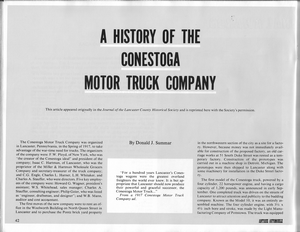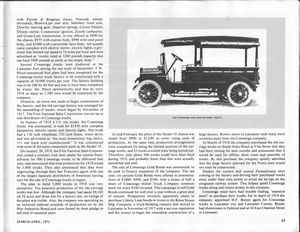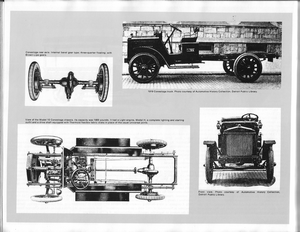|
By accessing or using The Crittenden Automotive Library™/CarsAndRacingStuff.com, you signify your agreement with the Terms of Use on our Legal Information page. Our Privacy Policy is also available there. |

A History of the Conestoga Motor Truck Company
|
|---|
|
|
A History of the Conestoga Motor Truck Company
Donald J. Summar
Antique Automobile
March-April 1972
This article appeared originally in the
Journal of the Lancaster County Historical Society and is reprinted here with the Society's permission.
"For a hundred years Lancaster's Conestoga wagons were the greatest overland freighters the world ever knew. It is but appropriate that Lancaster should now produce their powerful and graceful successor, the Conestoga Motor Truck..."
From a 1917 Conestoga Motor Truck Company ad.
The Conestoga Motor Truck Company was organized in Lancaster, Pennsylvania, in the Spring of 1917, to take advantage of the war-time need for trucks. The organizers of the company were: F.W. Ployd, of New York, who was "the creator of the Conestoga ideal" and president of the company; Isaac C. Hartman, of Lancaster, who was the proprietor of the Miller & Hartman Wholesale Grocers Company and secretary-treasurer of the truck company; and C.G. Engle, Charles L. Harner, L.H. Whitaker, and Charles A. Stauffer, who were directors. Five key employees of the company were: Howard G. Wagner, president's assistant; W.S. Whitehead, sales manager; Charles A. Stauffer, consulting engineer; Philip Geier, who was listed as "engineer, draftsman, and designer"; and W.B. Mann, auditor and cost accountant.
The first moves of the new company were to rent an office in the Woolworth Building on North Queen Street in Lancaster and to purchase the Pontz brick yard property in the northwestern section of the city as a site for a factory. However, because money was not immediately available for construction of the proposed factory, an old carriage works at 51 South Duke Street was rented as a temporary factory. Construction of the prototypes was carried out in a machine shop in Detroit, Michigan. The prototypes were then shipped to Lancaster along with some machinery for installation in the Duke Street factory.
The first model of the Conestoga truck, powered by a four cylinder, 22 horsepower engine, and having a cargo capacity of 1,200 pounds, was announced in early September. One completed truck was driven on the streets of Lancaster to attract attention and publicity to the budding company. Known as the Model 10, it was an entirely assembled machine. The four cylinder engine, with 3¼ x 4½ inch bore and stroke, was made by the Light Manufacturing Company of Pottstown. The truck was equipped with Parrish & Bingham frame, Norwalk tubular driveshaft, Brown-Lipe rear axle, Salisbury front axle, Ditwiler steering gear, Superior springs, Crown fenders, Dyneto starter, Connecticut ignition, Zenith carburetor, and Grant-Lees transmission. It was offered at $890 for the chassis, $975 with express body, $990 with steel panel body, and $1000 with convertible farm body. All models came complete with electric starter, electric lights, a governor that limited top speed to 18 miles per hour and were advertised as "trucks rated at 1200 pounds capacity that can haul 1800 pounds as easily as the empty body."
Several Conestoga trucks were displayed at the Lancaster Fair during the last week of September. F.W. Ployd announced that plans had been completed for the Conestoga motor truck factory to be constructed with a capacity of 10,000 trucks per year. The factory building was to be 200 by 60 feet and was to have been completed by winter. Mr. Ployd optimistically said that by early 1918 as many as 1,500 men would be employed by the company.
However, no move was made to begin construction of the factory, and the old carriage factory was arranged for the assembling of trucks, which began by November of 1917. The First National Sales Corporation was set up as sole distributor of Conestoga trucks.
In January of 1918 a 1½ ton model, the Conestoga Giant, was announced. It sold for $1450 with complete equipment, electric starter and electric lights. The truck had a 130 inch wheelbase, 192 inch frame, worm drive, and was advertised as "the most economical, big, heavy, 1½ ton truck ever manufactured." It was constructed with most of the same component parts as the Model 10.
On January 20, 1918, the First National Sales Corporation closed a contract with their dealer for central Pennsylvania for 500 Conestoga trucks to be delivered that year, and announced that total production for 1918 would be 5,000 trucks. They also announced that they were negotiating, through their San Francisco agent, with one of the largest Japanese distributors of American touring cars for the sale of Conestoga trucks in Japan.
The plan to build 5,000 trucks in 1918 was very unrealistic. The potential production of the old carriage works was low. Although the company had spent $9,105 on 16 acres and three lots for a factory site, no vestige of the plant was visible. Also, the company was operating on an enforced reduced schedule of production set by the War Industries Board,and were bound by their pledge to sell only to essential users.
In mid-February the price of the Model 10 chassis was raised from $890 to $1,050 to cover rising costs of production. At the same time production arrangements were completed for using the limited quarters of the carriage works, and 25 trucks a month were being turned out. Therefore, only about 300 trucks could have been built during 1918, and probably fewer than that were actually assembled and sold.
The sale of Conestoga Gold Bonds was announced, to be used to finance expansion of the company. The ten year, six percent Gold Bonds were offered in denominations of $1000, $500, and $100, with a bonus of half a share of Conestoga Motor Truck Company common stock for every $100 invested. This campaign to sell Gold Bonds continued for well over a year without a great deal of success. Prospective investors apparently chose to purchase Liberty Loan bonds or invest in the Rowe Motor Mfg. Company, a truck-building concern that moved to Lancaster in November of 1917 with a ten year reputation and the money to begin the immediate construction of a large factory. Rowe's move to Lancaster took many local investors away from the Conestoga company.
In March of 1918 the company purchased the old carriage works on South Duke Street at Vine Street that they had been renting for nine months and announced that it would be used for offices, show room and assembly of trucks. By this purchase the company quietly admitted that the large factory planned for the Pontz tract would not soon be constructed.
Dealers for eastern and central Pennsylvania were coming to the factory and driving their purchased trucks away under their own power to avoid the tie-ups on the congested railway system. This helped speed Conestoga trucks along and return money to the company.
Conestoga must have had trouble finding "essential users" to purchase their trucks, for in April of 1918 the company appointed H.F. Butzer agent for Conestoga trucks in Lancaster city and Lancaster County. Butzer had showrooms in Ephrata and at 44 East Chestnut Street in Lancaster.
The company continued to produce trucks during the rest of 1918, but after June production was limited to much less than 25 per month. Conestoga, like other truck assemblers, who had little or no war work, found themselves unable to secure deliveries of all the component parts needed in their trucks. Therefore, production was frequently delayed or halted by lack of necessary parts.
After purchasing the carriage works, the company had expanded and rebuilt the building to allow more working space. By the end of 1918 the company was able to commence the building of their own frames. The frame they made was of six inch rolled channel steel, rigidly reinforced with five cross members, large gusset plates angle sections. All the parts and castings were hot-rivited into place.
To face the increased competition after the armistice and make use of their own frames to best advantage, the company decided to introduce new models for 1919.
In early 1919 the Model 10 and the 1½ ton Giant were replaced by one - and two-ton models powered by Continental four cylinder engines. Almost all of the components used in the trucks were changed. The new models had Bosch magneto, Zenith carburetor, Fuller clutch and transmission, Columbia front axle, Wisconsin rear axle, Rowland springs, Ross steering gear, English & Messick radiator, Bimel wheels and Fisk tires.
The trucks were originally sold at $1850 for the one-ton chassis and $2150 for the two-ton chassis, and were advertised as "standardized on the most successful practice of truck building, combined with units of recognized superiority."
In May a 1,500 pound delivery truck selling for $900 with Prest-O-Lite headlights was introduced. It carried a "Victory" nameplate although it was built by Conestoga. It had Grant-Lees transmission, Borg & Beck clutch, Ditwiler steering gear, Parrish & Bingham frame, Berling magneto, and Special truck engine. Many of the units were apparently left over from the Model 10 production of 1918.
The campaign to sell Gold Bonds was revitalized. An ad explained how $100 invested in such companies as Reo, Hupp, Ford, Vim, Stutz and Overland had returned huge profits to the investors within just a few years, and implied that the same could be expected by investors in Conestoga Gold Bonds.
The company announced that the proceeds from the sale of bonds would be used for increasing factory facilities and production. The carriage works had been rebuilt and improved until it was four times its original size, but it was crowded and cramped and production was lagging. Production had been slowed by the change-over to new models and part suppliers, and production of three models instead of two.
Sale of Gold Bonds was proceeding slowly, even though one half of the common stock of the Company was held in trust and distributed pro rata amongst the bondholders as an added inducement to buy. An ad stated that, "orders are coming in, inquiries are piling up, larger quarters are necessary." However, larger quarters were not available. The South Duke Street factory allowed no further expansion on that site.
The price of the two-ton model was raised to $2550 in Juiy and production was further complicated and delayed when component changes were made to the Stromberg carburetor, Simms magneto, Shuler front axle and Silico manganese springs. Just why these changes were made is unknown, but apparently Ployd and his associates were trying to find a successful combination of components to enable them to market a truck that could compete successfully in the tough, post-war truck market.
The year 1919 was bad for small truck producers in general, and for companies like Conestoga in particular. A number of small companies had begun building trucks in 1916 and 1917 to take advantage of the need for trucks during the war. However, most of these companies had some other line of business to fall back on when sales declined in 1919 with the active return of such companies as General Motors, Mack, Republic, and Autocar to civilian truck production. Conestoga had nothing to fall back on. The modest profit that the company had made in 1918 was soon exhausted, and the company slipped into debt as 1919 progressed to summer and to fall.
A last effort was made to return the company to solvency by exporting trucks to Sweden, Holland, France, Italy, Japan and other countries. In late October the company shipped 20 or more trucks to Norway through its export office, located at 290 Broadway in New York City. A newspaper article said that "from every indication this is the beginning of a large and lucrative business."
Such was not to be the case. Debts continued to increase and on November 27, 1919, Isaac C. Hartman, treasurer of the company, went into United States District Court in Philadelphia to ask for a receiver to the company, which had insufficient capital to pay the bills that were due. The Pontz tract and the building on South Duke Street were heavily encumbered.
F.W. Ployd, who had been president of the company, was appointed receiver. He got permission to finish the partly built work in the factory.
The receiver's sale was prepared for and occurred on May 24, 1920. Five two-ton trucks, five one-ton trucks, and one 1,500 pound delivery truck were offered for sale, along with office and machine shop equipment.
The sale went poorly, and Mr. Ployd put an ad in the newspaper a few days later, which stated "For sale! Conestoga Motor Trucks at bargain prices. These trucks can be bought at private sale for about 50% off list price." Still the trucks could not be sold, for two weeks later four Conestoga trucks were offered at $1350 each, "which is about the cost of materials."
On June 11, 1920, the First National Sales Corporation went into receivership at the request of F.W. Ployd. The First National Sales Corporation owed $4640.46 to Conestoga, but like Conestoga was short of funds and ended up paying only $2337.26 of $7998.63 owed, including $1355.95 to Conestoga, which was distributed to the creditors.
A final sum of money came into Mr. Ployd for the creditors in July, when the Lancaster branch of the Philadelphia Automobile Radiator Repair Company, located at 16 South Duke Street, purchased all the radiator cores (which were numerous) from the receiver and then announced that they could "replace any truck radiator on the market at a reasonable price."
Thus, after a brief career as a truck producer, the Conestoga Motor Truck Company passed from the automotive scene, never more than a "tame cat."
And what of the Conestoga truck today? No trucks are known to have survived to the present to be restored and displayed. The factory on South Duke Street has been replaced by an ARCO service station. The Pontz tract has been turned to other industrial uses. Today there is almost no one still around who remembers that the Conestoga Motor Truck Company ever existed. This article is for them.

















 Topics: Conestoga
Topics: Conestoga




